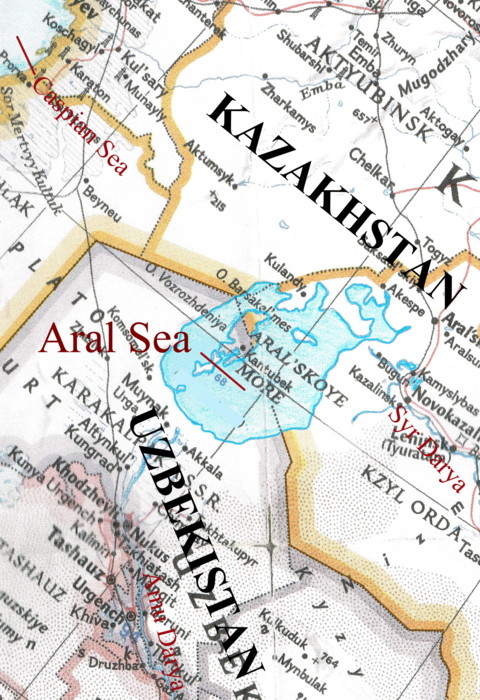Disappearing Aral Sea
In 2000, there were reports about the ecological disaster of the Aral Sea. Now, after 13 years there are improvements but also deterioration of its condition.
 Aral Sea is actually an inland lake located east of Caspian Sea and covers about 68,000 sq.km area shared by Kazakhstan and Uzbekistan.
It was once the fourth-largest body of fresh water on the earth, with inflows from two rivers — Syr Darya north in Kazakhstan and Amu Darya south in Uzbekistan.
Back before 1960 fishermen had enjoyed a busy life at the sea, Its water has been disappearing from early 1960s in the past Soviet Government to
divert water to irrigate agricultural lands. In a few decades, as the water became salty and the salinity rose from 10 to 30 grams per litre and the fish disappeared.
In the early 1980s, the fishing industry collapsed and the sea became a dessert dotted with ghostly hulks of ship wrecks. The sea is becoming the worst environmental catastrophe
caused by man in history.
Aral Sea is actually an inland lake located east of Caspian Sea and covers about 68,000 sq.km area shared by Kazakhstan and Uzbekistan.
It was once the fourth-largest body of fresh water on the earth, with inflows from two rivers — Syr Darya north in Kazakhstan and Amu Darya south in Uzbekistan.
Back before 1960 fishermen had enjoyed a busy life at the sea, Its water has been disappearing from early 1960s in the past Soviet Government to
divert water to irrigate agricultural lands. In a few decades, as the water became salty and the salinity rose from 10 to 30 grams per litre and the fish disappeared.
In the early 1980s, the fishing industry collapsed and the sea became a dessert dotted with ghostly hulks of ship wrecks. The sea is becoming the worst environmental catastrophe
caused by man in history.
In 1987, the lake began to split into two — a small north part and a larger south part. In 1991, the Soviet Union broke up; Kazakhstan and Uzbekistan became two independent countries.
Some restoration efforts of the sea were attempted with funding from the World Bank but brought only temporary results. By 2003, the South Aral Sea was further divided into two portions - western and eastern.
Source: National Geographic Society - 1990
In 2003, Kazakhstan started a serious restoration with the help from the World Bank to build a 13 km (eight mile) dam to rise the water levels of the North Aral Sea. The dam was completed in 2005. Right now, the salinity has dropped significantly to allow native fish to return.
NASA Photos: Left - 1989, Right - 2008


Photos: Left - 2010 Right - 2012
Meanwhile, the South Aral Sea is basically abandoned. In 2012, the eastern part was almost dried up. Uzbekistan has given up the sea and keeps to use the water of Amu Darya river to irrigate
the cotton field. Uzbekistan is one of the major cotton producers in the world; and the government also intends to explore the dried sea for mineral and energy resources.
The drying of Aral Sea has brought havoc to local communities - with the displacement of population. The blown-up dry residues of fertilizers and pesticides leached into the sea are causing health problems
to the remaining population. It also made the local climate noticeably harsher with alternating extreme temperatures — day to night and summer to winter. From satellite photos, the cloud patterns over the sea
take the unusual shape of the water body might lead a clue if the water evaporation of the sea could contribute to the climate.
Reference: earthobservatory.nasa.gov/Features/WorldOfChange/aral_sea.php